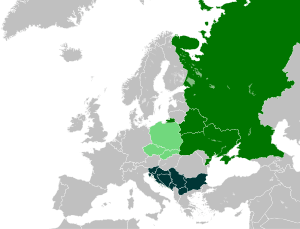Boykos
 Boyko inhabitants of Galicia, lithograph from 1837 | |
| Regions with significant populations | |
|---|---|
| 131 (2001)[1] | |
| 258 (2011)[2] | |
| Languages | |
| Ukrainian language | |
| Religion | |
| Greek Catholicism, Orthodox Christianity | |
| Related ethnic groups | |
| Ukrainians · Rusyns · Lemkos · Hutsuls | |
| Part of a series on |
| Ukrainians |
|---|
 |
| Diaspora |
|
see Template:Ukrainian diaspora |
| Closely-related peoples |
|
East Slavs (parent group) Boykos · Hutsuls · Lemkos · Rusyns Poleszuks · Kuban Cossacks Pannonian Rusyns |
| Culture |
|
Architecture · Art · Cinema · Cuisine Dance · Language · Literature · Music Sport · Theater |
| Religion |
|
Eastern Orthodox (Ukrainian) Greek Catholicism Roman Catholicism Judaism |
| Languages and dialects |
|
Ukrainian Russian · Canadian Ukrainian · Rusyn · Pannonian Rusyn Balachka · Surzhyk · Lemko |
|
History · Rulers List of Ukrainians |
Boykos (Cyrillic: Бойки, Polish: Bojkowie, Slovak: Pujďáci), or simply Highlanders (verkhovyntsi) are a Ukrainian ethnographic group located in the Carpathian Mountains of Ukraine and Poland. Along with the neighboring Lemkos and Hutsuls, the Boykos are a sub-group of the Ukrainian people and speak a dialect of the Ukrainian language.[3][4] Boykos differ from their neighbors in dialect, dress, folk architecture, and customs.
In Ukraine, the classification of Boykos and other Rusyns as an East Slavic ethnicity, distinct from Ukrainians is controversial.[5][6][7] (The deprecated and archaic term Ruthenian, while it is also derived from Rus', is ambiguous, as it technically may refer to Rusyns and Ukrainians, as well as Belarusians and even Russians, depending on the historical period.) According to the 2011 Ukraine census only 131 people identified themselves as Boykos, separate from Ukrainians.[8] However, this figure is distorted for two reasons: some people otherwise identifiable as Boykos regard that name as derogatory,[9] In the Polish census of 2011, 258 people identified their nationality as Boyko, with 14 people listing it as their only national identification.
Location
- Poland: southeasternmost part of Poland (Podkarpackie Voivodeship).
- Ukraine: central and western half of the Carpathians in Ukraine across such regions as the southern Lviv Oblast (Skole, Turka, Drohobych, Sambir and Stary Sambir Raions), western Ivano-Frankivsk Oblast (Dolyna and Rozhniativ Raions) and parts of the northeastern Zakarpattia Oblast (Mizhhiria Raion)
- northeast Slovakia
To the west of Boykos live Lemkos, east or southeast - Hutsuls, to the south or southwest - Carpathian Rusyns.
-

Ethnographic groups of southeasternmost Poland, Boykos in dark blue.
-

Highlander groups of easternmost Ukraine, Boykos in brown.
Origin
The name "Boyko" is thought by some to originate in their patterns of speech, specifically the use of the affirmative exclamation "bo-ye!", meaning the only or because it is so. Example: "Nu, bo vono tak i ye.", "This is the way it is." In modern Ukrainian language, the word bo is not common and considered to be an archaism, yielding to its alternative ale. The word bo was first coined by the priest Joseph Levytsky in the foreword of his Hramatyka (1831).
One view proposed by Soviet scholars considers the Boykos an autochthonous population with specific language and dialectal features, of which their use of bo ye meaning "yes" is a prominent example (hypothesis of I. Verkhratsky).[10] An older view proposed by the 19th century authors I. Vahylevych, Ya. Holovatsky, and P. Šafárik links the Boyos to the Celtic Boii, a tribe unattested since the beginning of the Christian Era.
Most Boykos belong to the Ukrainian Greek Catholic Church, with a minority belonging to the Ukrainian Orthodox Church. The distinctive wooden church architecture of the Boyko region is a three-domed church, with the domes arranged in one line, and the middle dome slightly larger than the others.
Legacy
In memory of Boykos, Verkhovna Rada renamed Telmanove Raion into Boykivske Raion where Boykos were deported from Czarna, Bieszczady County (today in Poland) after the 1951 Polish–Soviet territorial exchange.
See also
- Hutsuls
- Lemko
- Ukrainians
- Ruthenians
- Bojka
- Ukrainian dance
- Boychuk
- Boichuk
References
- ↑ Ukrainian Census 2001
- ↑ Ludność. Stan i struktura demograficzno-społeczna. Narodowy Spis Ludności i Mieszkań 2011 (National Census of Population and Housing 2011). GUS. 2013. p. 264.
- ↑ [Richard T.Schaefer (ed.), 2008, Encyclopedia of Race, Ethnicity, and Society, Volume 1, SAGE Publications, p. 1341.
- ↑ James Stuart Olson, Lee Brigance Pappas & Nicholas Charles Pappas, 1994, An Ethnohistorical Dictionary of the Russian and Soviet Empires, Greenwood Publishing Group, pp. 109–110.
- ↑ Professor Ivan Pop: Encyclopedia of Subcarpathian Ruthenia(Encyclopedija Podkarpatskoj Rusi). Uzhhorod, 2000..
- ↑ Paul Robert Magocsi, Encyclopedia of Rusyn History and Culture . University of Toronto Press, June 2002.
- ↑ Tom Trier (1998), Inter-Ethnic Relations in Transcarpathian Ukraine
- ↑ http://narodna.pravda.com.ua/history/4cea4c63e60e0/.
- ↑ Sofiia Rabii-Karpynska, 1984, "Boikos" in: Encyclopedia of Ukraine, vol. 1
- ↑ Nikitin, AG; Kochkin IT; June CM; Willis CM; McBain I; Videiko MY (February 2009). "Mitochondrial DNA sequence variation in Boyko, Hutsul and Lemko populations of Carpathian highlands.". Human Biology. 81 (1): 43–58. doi:10.3378/027.081.0104. ISSN 0018-7143. OCLC 432539982. PMID 19589018.
MtDNA haplogroup frequencies in Boykos were different from most modern European populations.
External links
- Anatoliy Ponomariov. "Ethnic groups of Ukrainians" (in Ukrainian). Available online.
- Nakonechny, Ye. "How Ruthenians became Ukrainians", Zerkalo Nedeli (the Mirror Weekly), July, 2005. Available online in Russian and in Ukrainian.
- Short photo essay about contemporary Boiko life.
- Boikos in the Encyclopedia of Ukraine
- Romaniuk, K. Characteristics of Boikos dialect use in Kherson region in the mid 20th century. "Domiv". 8 March 2016.

